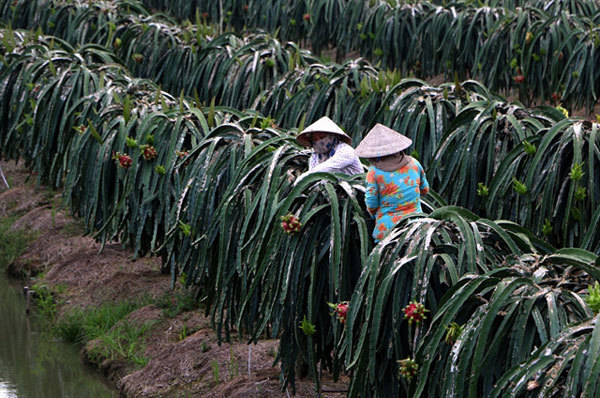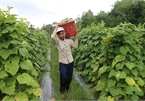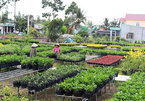 |
|
A dragon fruit orchard in Hau Giang Province’s Chau Thanh A District.
|
The conversion to other crops to adapt to climate change and market demand has offered farmers higher incomes in recent years, according to the province Department of Agriculture and Rural Development.
Located in the centre of the delta and with a dense river and canal network, Hau Giang grew mostly rice and sugarcane in the past, but many farmers have switched to other crops in recent years with the encouragement of authorities.
Dang Tan But in Chau Thanh A District’s Tan Phu Thanh Commune had 1.5ha of low-yield paddies and switched to growing seedless lime three years ago. He now harvests around three tonnes of the fruit every month.
“I earn VND48 million (US$2,000) a month, five times the income from rice,” he said.
While some have switched completely to other crops, others rotate them with rice.
In the province’s low-lying areas, many rice farmers have stopped growing the autumn-winter, or the year’s third crop, and have switched to breeding fish and other aquatic species since it is the flood season in the delta.
Farmers have switched from rice to fruits, vegetables and other crops on a total of 12,230ha since 2017.
During the current winter-spring rice season, many farmers have switched to short-term crops like water melon, cucumber and corn for the first time.
They offer them 1.5 – 3 times higher incomes than rice, help prevent the spread of diseases and improve soil fertility, according to the department.
Others have switched to other high-value crops from certain fruits and sugarcane on nearly 18,000ha since 2014.
Hau Giang, the largest sugarcane producer in the delta, is expected to have nearly 6,000ha under the crop this year, down by a third from last year, according to the department.
Authorities encourage farmers to mechanise, adopt advanced farming models like growing vegetables in net houses and use efficient irrigation systems.
Tran Chi Hung, director of the department, said the province would focus on developing infrastructure to serve agricultural needs, including irrigation systems and roads, step up investment in research, adopt advanced farming technologies, and strengthen links between farmers and companies to establish large farming areas by persuading farmers to pool lands.
Hau Giang has five such large rice fields with a total area of 2,500ha in Vi Thanh, Chau Thanh A and Long My districts and Long My Town.
Machines are used to till and harvest them, according to the department.
The province has also established many such large areas for fruits, sugarcane and aquaculture.
In recent years it has carried out many projects to sustainably develop agriculture, including setting up electric pumping stations, and developing quality breeds and strains.
Tran Thanh Toan, head of the province’s Irrigation Sub-department, said the electric pumping stations help control floods, drought and saltwater intrusion in many places.
“[They] have enabled localities to establish large farming areas.” VNS

Mekong Delta farmers switch to other crops in response to climate change
More farmers in the Mekong Delta have restructured their crop cultivation to adapt to the effects of climate change.

Vietnam's Mekong Delta agriculture adapts to climate change
The Mekong Delta has restructured agriculture towards climate-change adaptation and market demand by establishing specialised farming areas for its key agricultural products.
 The Mekong Delta province of Hau Giang plans to grow other crops on around 4,000ha of fields which only grow one rice crop a year or are unproductive by 2030.
The Mekong Delta province of Hau Giang plans to grow other crops on around 4,000ha of fields which only grow one rice crop a year or are unproductive by 2030.